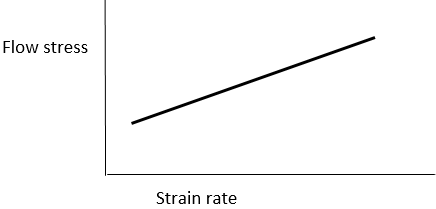This set of Mechanical Metallurgy Question Bank focuses on “Tension Test – Effect of Strain Rate on Flow Properties – 2”.
1. The unit of strain rate is ____________
a) sec
b) sec-1
c) sec-2
d) unit less
View Answer
Explanation: The strain rate is defined as a change in strain over time.
-> Strain rate=ε/t
-> ε is unit less quantity, t has unit sec
-> 1/sec=sec-1.
2. The dependence of the strain rate on the strength of the material _____________ with the increase in temperature.
a) increases
b) decreases
c) remains constant
d) no relationship
View Answer
Explanation: The dependence of the strain rate on the strength of the material increases with the increase in temperature. So the change in the strength of the material at a higher temperature will be much greater than at lower temperature.
3. Increasing the strain rate ______________ the flow stress.
a) increases
b) decreases
c) does not change
d) no relationship
View Answer
Explanation: The increase in the strain rate increases the flow stress in the material. This can be seen in this next curve.

4. The dependence of the flow stress on the strain rate is _________
a) more prominent at higher strain
b) is more prominent at lower strain
c) constant at all the strain values
d) no relationship
View Answer
Explanation: The dependence of the flow stress on the strain rate (or the variation in flow stress) is much higher at low strain values than compared to higher strain values.
5. The low carbon steel does not show yield point phenomena, but if the strain rate is sufficiently high, the yield point might appear in the flow curve.
a) True
b) False
View Answer
Explanation: If the strain rate is high, the meager amount of carbon atoms is also capable of pinning down the dislocation and cause fluctuation in the flow curve.
6. If the crosshead velocity of the UTM machine is v, the strain rate is given as ϒ, and the initial length of the sample is L, find the strain rate of the specimen in terms of crosshead velocity and sample length?
a) v
b) v/L
c) L/v
d) v*L
View Answer
Explanation: Strain rate is = strain/time
-> [d(Lf-L)/L]/dt; where the Lf is final length of specimen and dt is the short change in time
-> 1/L [dL/dt]
-> v/L
So strain rate is directly proportional to crosshead velocity.
7. The strain rate calculated from engineering strain and correct strain gives the same result.
a) True
b) False
View Answer
Explanation: The obtained value of the strain from engineering strain and true strain are different. So the strain rates are also different for both. These are defined as conventional strain rate and engineering strain rate.
8. The true strain rate is given as ϒ, and conventional strain rate is given as ε. The engineering strain is equal to e. The relationship between conventional strain rate and true strain rate is _______
a) ϒ = ε
b) ϒ = ε/e
c) ϒ = ε/(1+e)
d) ϒ = ε*e
View Answer
Explanation: The conventional strain rate is defined by taking the initial length of specimen whereas the true strain rate takes instantaneous length into the calculation. So the relationship between them is:
True strain rate = Conventional strain rate / (1+Engineering strain).
9. If the crosshead velocity of the machine is kept constant, the true strain rate of the sample will _________ with an increase in the length of the sample.
a) increase
b) decrease
c) remain constant
d) vary
View Answer
Explanation: The true strain rate is given as:
-> velocity/instantaneous length
So, if the velocity is kept constant, and length is increasing, the true strain rate will automatically decrease.
10. To maintain the constant true strain rate of a sample, the crosshead velocity should increase with the increase in the length of the specimen. What will be the optimum velocity with the change in length to keep the true strain rate constant? (True strain rate=ϒ, L=length of sample, t=time).
a) v=ϒ
b) v=ϒ*L
c) v=ϒ*L*exp(ϒt)
d) v=ϒ*L*exp(ϒ/t)
View Answer
Explanation: As the sample length increases, the true strain rate decreases due to the relationship
-> Velocity / instantaneous length
So, velocity needs to increase with the change in time to compensate for the change, and the change should follow:
-> v= ϒ*L*exp(ϒt).
Sanfoundry Global Education & Learning Series – Mechanical Metallurgy.
To practice Mechanical Metallurgy Question Bank, here is complete set of 1000+ Multiple Choice Questions and Answers.
If you find a mistake in question / option / answer, kindly take a screenshot and email to [email protected]
- Check Metallurgical Engineering Books
- Apply for Metallurgical Engineering Internship
- Check Mechanical Metallurgy Books
- Practice Metallurgical Engineering MCQs
